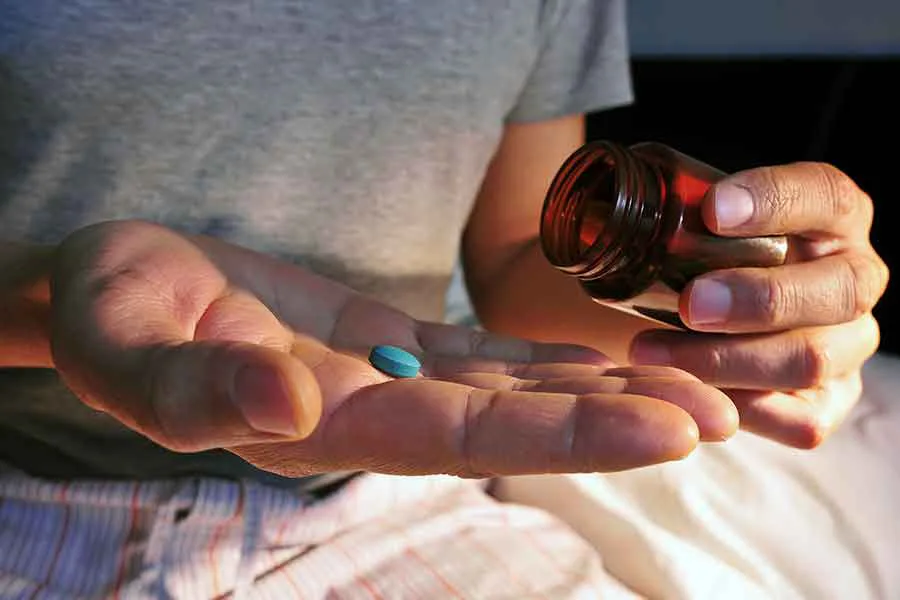Oxycodone and Hydrocodone are both opioid pain relievers. Opioids are a class of chemically related drugs that interact with opioid receptors in the nervous system throughout the body.
This drug class includes both legal substances, such as oxycodone, hydrocodone, codeine, morphine, and fentanyl, and illegal substances, such as heroin. The interaction between opioids and their designated receptors causes pain relief and euphoria, and this combination results in a high abuse potential. Oxycodone and hydrocodone are both very potent and therefore typically prescribed for moderate to severe pain.
Oxycodone and Hydrocodone Are Synthesized From Different Compounds
Both drugs are semi-synthetic opioids derived from opioid alkaloid compounds in poppy flowers, though their synthesis source varies; hydrocodone is derived from codeine, while oxycodone is derived from thebaine. Because hydrocodone is derived from codeine, a common ingredient in cough suppressants, it is also sometimes used as an antitussive.
Oxycodone and Hydrocodone-Combination Products Are Classified in Different Drug Schedules
While oxycodone and pure hydrocodone are both classified as Schedule II drugs, pure hydrocodone is rarely prescribed in the United States. Instead, clinicians typically prescribe a prepared combination of acetaminophen (or another NSAID) and hydrocodone, which is classified as a Schedule III drug. Schedule II drugs are noted as having a strong potential for abuse or addiction, though they also have appropriate medical uses. Schedule III drugs have a lesser potential for abuse or addiction. Learn more about drug scheduling from the DEA.
Hydrocodone and Oxycodone Are Likely Equally Effective
Studies have shown that there is little difference in terms of the analgesic effects of the two drugs; they have both been described as moderately potent.
Hydrocodone and Oxycodone are Both Available in Combination Products
Hydrocodone is usually combined with an NSAID before sale. Oxycodone is available as both a single-ingredient product and in immediate-release formulations with either NSAIDS or acetaminophen. Oxycodone is sometimes combined with naloxone in an abuse-deterrent combination, as naloxone triggers opioid withdrawal symptoms and suppresses the effects of the oxycodone.
Oxycodone is Available Via A Greater Number of Routes of Administration Than Hydrocodone
Oxycodone can be taken by mouth, sublingually, intramuscularly, intravenously, intranasally, subcutaneously, transdermally, rectally, and/or via an epidural. Hydrocodone is only given orally in clinical settings, though individuals attempting to abuse the drug may take it intranasally or rectally.
Hydrocodone is Classified as Potentially Having More Risk During Pregnancy Than Oxycodone
Hydrocodone is classified in pregnancy category C, indicating that risk to the mother and/or child has not been ruled out. It means that there are not enough adequate/well-controlled human trials to make an informed assessment, but non-human studies have shown an adverse effect on the fetus. Potential benefits may still outweigh the risks for pregnant women, however.
Oxycodone is classified in pregnancy category B, indicating that no risk has been found in non-human studies. This means that either animal studies have failed to indicate a risk to the fetus and there are not enough adequate/well-controlled human trials to make an informed assessment in those terms, OR that animal studies have indicated a risk to the fetus but adequate/well-controlled human trials have failed to demonstrate a risk to the fetus in any trimester.
Oxycodone and Hydrocodone Have Different Pharmacokinetics
Oxycodone has a high percentage of bioavailability, 60-87%, which means that a lot of the drug reaches the bloodstream after it is taken. Hydrocodone, by contrast, has a low bioavailability of 25%. In addition, oxycodone has a higher percentage of molecules that bind to proteins, which means that it is excreted more slowly and has a harder time penetrating tissues in the body.
Oxycodone has an onset of action of 10 to 30 minutes when taken in an immediate-release formulation and an hour when taken in a controlled-release formulation. Hydrocodone has an onset of action of 10 to 20 minutes.
Oxycodone has a duration of action of three to six hours when taken in an immediate-release formulation and 12 hours when taken in a controlled-release formulation. Hydrocodone has a duration of action of four to eight hours.
Oxycodone and Hydrocodone Share Similar Potential Side Effects
Common side effects of both opioids include:
- Nausea/vomiting
- Constipation
- Drowsiness
- Somnolence
- Dizziness
- Lightheadedness
- Anxiety
- Mood swings
- Dry mouth/throat
- Difficulty urinating
- Rashes
- Itching
- Constricted pupils
- Sweating
Signs of opioid overdose may include:
- Constipation
- Nausea and/or vomiting
- GI tract spasms
- Low blood pressure, weak pulse
- Lack of responsiveness, even to painful stimuli
- Constricted pupils (non-reactive to light)
- Cyanosis (blue colored fingernails, lips)
- Difficult to wake up; extreme sedation
- Coma
- Seizures
- Respiratory arrest (slow, shallow breathing or no breathing at all)
Signs of opioid withdrawal may include:
- Restlessness
- Chills
- Agitation
- Insomnia
- Sweatiness
- Nausea and/or vomiting
- Muscle or bone pain
- Depression
- Diarrhea
Learn more about Oxycodone side effects and addiction
Sources Cited:
https://www.drugs.com/cons/hydrocodone.html
https://www.drugs.com/mtm/oxycodone.html
http://www.drugandalcoholdependence.com/article/S0376-8716(08)00411-0/fulltext
https://www.womenshealth.gov/publications/our-publications/fact-sheet/pregnancy-medicines.html
https://books.google.com/books?id=Em7OBQAAQBAJ&pg=PA82#v=onepage&q&f=false
https://books.google.com/books?id=kBZ6DAAAQBAJ&pg=PA1081#v=onepage&q&f=false

